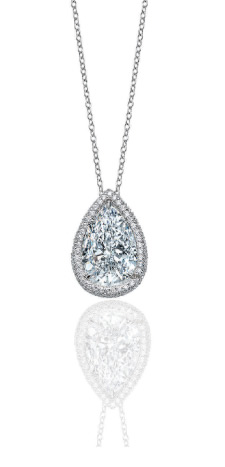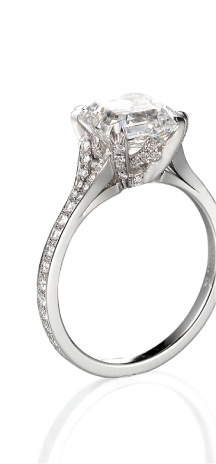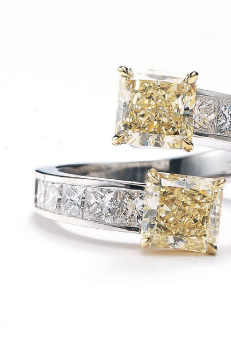FOUR C'S
Cut is the only one of the 4Cs controlled by man. Based on scientific formulas, a well-cut diamond will internally reflect light from one mirror - like facet to another and disperse and reflect it through the top of the stone. This results in a display of brilliance and fire. Diamonds that are cut too deep or too shallow lose or leak light through the side or bottom, resulting in less brilliance and ultimately, value.
Cut also refers to shape - round, square, pear, or heart for example. Non-round shapes, also known as "fancy shapes," will have their own guidelines to be considered well-cut.
All Daniel K diamonds are manufactured to the most exacting standards of cut, thereby maximising their sparkle.

CUT
Refers to the angles and proportions of a diamond
Cut is the only one of the 4Cs controlled by man. Based on scientific formulas, a well-cut diamond will internally reflect light from one mirror - like facet to another and disperse and reflect it through the top of the stone. This results in a display of brilliance and fire. Diamonds that are cut too deep or too shallow lose or leak light through the side or bottom, resulting in less brilliance and ultimately, value.
Cut also refers to shape - round, square, pear, or heart for example. Non-round shapes, also known as "fancy shapes," will have their own guidelines to be considered well-cut.
All Daniel K diamonds are manufactured to the most exacting standards of cut, thereby maximising their sparkle. 

COLOR
Refers to the degree to which a diamond is colorless
Daniel K collections use white and fancy colored diamonds.
White Diamonds
White diamonds are usually graded on a color scale which ranges from D (colorless) to Z. This scale refers to the degree to which a diamond is colorless. The less color a diamond has, the more valuable it is.
Color differences are very subtle and it is very difficult to see the difference between, say, an E and an F. Therefore, colors are graded under controlled lighting conditions and are compared to a master set for accuracy.
Truly colorless stones, graded D, are treasured for their rarity. At Daniel K, we only use diamonds graded from D to G. These colors are so rare, that less than 1 percent of world's diamond production achieves these colors.
Fancy Colored diamonds
In addition to ice white diamonds, Daniel K uses an array of fancy colored diamonds in his jewelery, including yellows and pinks. Fancy yellow colors in particular feature in a number of Daniel K collections. Less than one in 10,000 diamonds is fancy yellow.

CLARITY
Refers to the presence of inclusions in a diamond
Inclusions are natural identifying characteristics such as minerals or fractures, appearing while diamonds are formed in the earth. They may look like tiny crystals, clouds or feathers.
To view inclusions, jewelers use a magnifying loupe. This tool allows jewelers to see a diamond at 10x its actual size so that inclusions are easier to see. The position of inclusions can affect the value of a diamond. There are very few flawless diamonds found in nature, thus these diamonds are much more valuable.
Inclusions are ranked on a scale of perfection, known as clarity. The clarity scale, ranging from F (Flawless) to Included (I), is based on the visibility of inclusions at a magnification of 10x.
The greater a diamond's clarity, the more brilliant, valuable and rare it is.

CARAT
Refers to the weight of a diamond
Carat is often confused with size even though it is actually a measure of weight. One carat is equivalent to 200 milligrams. One carat can also be divided into 100 "points." A 0.75 carat diamond is the same as a 75-points or 3/4 carat diamond.
A 1-carat diamond costs exactly twice the price of a half-carat diamond, right? Wrong. Since larger diamonds are found less frequently in nature, which makes them rarer, a 1-carat diamond will cost more than twice a 1/2-carat diamond (assuming color, clarity and cut remain constant).
Cut and mounting can make a diamond appear larger (or smaller) than its actual weight. So shop around and talk to your jeweler to find the right diamond and setting to optimize the beauty of your stone.
Daniel K specialises in creating jewelry using diamonds that range from 0.50 carat to over 10.00 carats in size.

THROUGH THE EYES OF A JEWELER
“Art is an evolution. My passion is the lost art of creating fine handmade jewelry.”
“When selecting a diamond you have to look beyond the details and pick a gemstone that speaks to you heart and mind”
